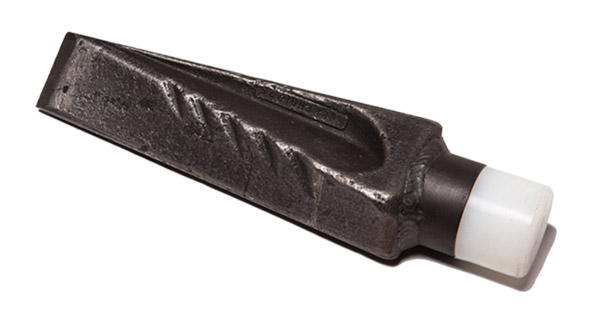

RIVING KNIFE FOR HARD WOOD
WHEN THE SPLITTING AX REACHES ITS LIMITS, SPLITTING WEDGES ENSURE HANDY LOGS

As soon as you need logs for a log fire or want to store wood for other purposes, you should never store cut wood without splitting. On the one hand, the longer it dries, the more difficult it is to split, and on the other hand, its calorific value is reduced because an internal putrefaction sets in. However, if the cut wood is processed as quickly as possible, the logs can dry better, which increases their calorific value.
There are various ways to split logs. As an alternative to the costly and space-intensive hydraulic log splitter, the sporty grip on the splitting ax is usually worthwhile. However, some logs or types of wood are so branched or hardened that even a splitting ax reaches its limits. At this point special devices are used: riving knife and splitting hammer.
ENORMOUS POWER THROUGH SPECIAL DESIGN
Felling wedges are available in different shapes, sizes and designs. Thanks to their special design, they are particularly suitable for splitting hard wood and meter pieces. The wedge surfaces are provided with a special profile. Lateral scales prevent the wedge from jumping out, the grooves and ridges provided ensure better guidance, reduce resistance and at the same time increase the splitting effect. To ensure that the wedge is better in the wood when it is attached, our riving knife with its sharp tip is easy to attach and quickly finds a good hold in the wood thanks to special notches. All these properties of the splitting wedges ensure that firewood can be split into handy, easy-to-transport and quick-drying logs with just a few strokes.
ROTARY WEDGES ARE EVEN MORE EFFECTIVE
A special type of riving knife is the so-called rotary riving knife. Their special shape also helps to break the wood apart when splitting. By twisting them, the force of the impact is transferred even more effectively into the wood, since the splitting effect increases enormously due to the wider wedge angle. Since our riving knives are forged from hardened steel, you should use a plastic hammer, or use our "Safety" range for riving wedges and splitting hammers. With their special polymer striking surfaces, they prevent metal splinters from splintering.
TARGETED USE
No matter which model you ultimately use, the use of riving knife always follows the same principle: Place the wedge closer to the edge and make sure that it is as parallel as possible to the grain with the cutting edge pointing vertically inwards. Now you can drive it in with light hammer blows - if necessary with a small hammer - until it is firmly seated. The wedge is then hammered into the wood with a heavy hammer until it breaks apart. Ideally, use a special splitting hammer that still has an ax head on one side. So you can - if necessary - help with targeted blows without having to change your tool too often. If the wedge disappears in the wood - what can happen especially with meter pieces, you can use a second, Add a longer wooden wedge until the wood is in two. Whichever hammer you choose, make sure that you never hit steel wedges with steel surfaces.
PAY ATTENTION TO SAFETY
As with all woodwork, it is important to pay attention to your own safety and that of your surroundings when splitting with wedges. Wear appropriate protective clothing and goggles to protect you against flying fragments. Because when the steel of the hammer hits the steel wedge, there can be dangerous chips. Our steel wedges are rounded on the face to protect them from chipping, but if you don't want to do without the quality of a forged riving knife or splitting hammer, you can use our "Safety" series. With these riving knives and split hammers, a polymer striking surface cushions against impact, which significantly reduces the risk of metal chips.
If you also want to counter the risk of losing a wedge, you can apply a coat of signal paint (e.g. red or neon yellow) with a spray can. Because how quickly it happened and a wedge gets lost outside - especially if you use it in the forest. The wedge is not necessarily more beautiful, but more noticeable.
- Gardening Tips (6)
- Tools (4)
- Irrigation (0)
- Ponds (3)
- Planter Ideas (7)
- Products (3)
- Homemade Compost & Fertiliser (2)
- Conserve Bees & Bugs (1)
- Ambassadors (2)


